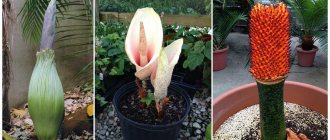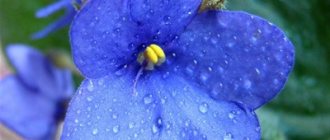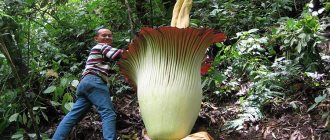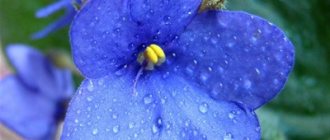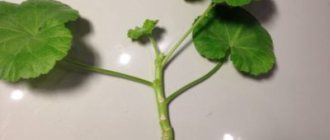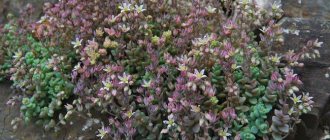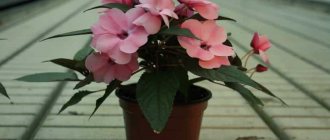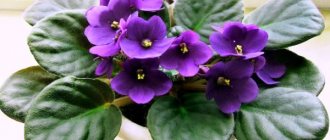- Amorphophallus bulbous or bulbous (bulbifer). The tuber is small (7–8 cm), similar to a ball cut in half. The length of a single leaf is about 1.5 m. Small tubers develop at both ends of the petiole. The length of the bedspread is approximately 20 cm, the inflorescence is 30 cm. The outside of the petal at the base is reddish, from bottom to top this shade gradually changes to greenish-pink. The inside is lime color. The ear is white-yellow, pointed upward. The boundary between male and female flowers is clearly visible.
- Amorphophallus cognac (konjac). The tuber is in the shape of an almost regular ball with a diameter of about 20 cm. Leaf length is up to 1 m. Peduncle height is 70–80 cm. Olive-colored petioles with lighter and darker spots. The blanket does not completely cover the cob, being approximately half as long (about 25 cm). The plant owes its name to the national Japanese dish “konjaku”, which is prepared from its tubers. Most often used in oriental medicine.
- Amorphophallus bell-shaped (campanulatus). The leaves are round, dissected into three lobes, approximately 25–30 cm in diameter. The spadix is short, the spathe is almost four times shorter. The petal shimmers in shades of deep purple and inky violet.
- Amorphophallus rivera (rivieri). Very large (up to 30 cm in diameter and up to 5 kg in weight) tubers. The length of the wide leaf, similar to a fan, is about 1 m. It is divided into three lobes, each segment, in turn, also pinnately dissected. The petiole is covered with pale green or dark brown spots. The length of the inflorescence and the spathe are approximately the same. Sticky drops form on the cob. The shade of the petal changes from dark scarlet at the base to almost black with a purple tint.
- Amorphophallus titanium (titanum). Fully lives up to the name. Tuber diameter is 45–50 cm, weight is up to 50 kg. The leaf is round, cut into 3 parts, about 3 m high and wide. The length of the petiole, covered with transverse whitish strokes, is up to 5 m, thickness is 10 cm. The cover (70–80 cm) is soft green on the outside, chocolate and red-violet on the inside. low tide The length of the cob is more than 2 m, about 5000 flowers bloom simultaneously. Amorphophallus titanica has been the official symbol of the Indonesian Botanical Garden for more than 120 years. Currently, it is practically not found in nature. Each specimen in greenhouses or botanical gardens has its own unique name and is the object of the closest observation by scientists.
- Amorphophallus paeoniifolius. The popular name is “elephant yam”. The mass of the tuber is up to 15 kg, diameter is 30–40 cm. The cover is lilac-green, the upper edge looks like a frill. The petiole is very short, which is why the inflorescence looks like a mushroom. Like the lower part of the petal, it is covered with spots. Sheet diameter is from 0.5 to 3 m.
- Amorphophallus dwarf or pygmy (pygmaeus). Very popular among gardeners due to its size. Height - no more than 0.5 m. The inflorescence is snow-white, very elongated, the cover is the same color. The unpleasant smell lasts only the first night after the flower blooms. The leaves are a very dark green color, and from a distance they can easily be mistaken for black.
Photo gallery: amorphophallus grown at home
A unique feature of Amorphophallus bulbiferous is the formation of tubers at the ends of the petiole The name of Amorphophallus konjac comes from the national Japanese dish, despite the fact that the first association is with an alcoholic drink Amorphophallus campanulata has a rather short spathe Amorphophallus rivera is often found at home There are very few plants for which the name fits larger than Amorphophallus titanica Amorphophallus pionifolia is a rather atypical representative of the genus Amorphophallus dwarf, compared to its relatives, it has very modest dimensions
Main characteristics and photos of amorphophallus
The humid tropics of China and India are considered the homeland of this flower, but various species can be found in the tropical and subtropical regions of Africa, Asia, Australia and many Pacific islands.
From Greek amorpho is translated as shapeless, phallus - phallus
Amorphophallus is a deciduous plant of the Araceae family. From the Greek amorpho is translated as shapeless, phallus - phallus. The plant belongs to the ephemeroids - in the dormant stage for a long time. In a short growing season, amorphophallus manages to bloom, grow leaves, shed them and go to rest. Apparently, due to this quality, as well as the fact that the blooming flower emits a very unpleasant smell of spoiled meat, this plant is not particularly popular among gardeners.
In a short growing season, amorphophallus manages to bloom, grow leaves, shed them and go on vacation
Phases of flower development
The genus Amorphophallus has about a hundred species of plants, very different in size, with flower stalks from 30 cm to 5 meters. These plants develop from tubers similar to beets, weighing up to 90 kg in some species. The tuber is dormant for about six months. The above-ground part of the plant consists of a single thick shoot, on which a powerful, strongly dissected leaf develops, and the flower becomes like a palm tree. In indoor conditions, the leaf unfolds most often in April. The amorphophallus remains in this state until October, then the shoot turns yellow and dies, and the plant begins a dormant period. In the spring of next year, a new leaf will appear, larger and taller than the previous one and with a more dissected leaf blade.
It's hard to believe that this tree is an amorphophallus leaf
Amorphophallus blooms after waking up and before the leaf appears. Flowering is short-lived, usually about two weeks. At this time, the tuber greatly decreases in size, having spent its nutrient reserves on the development of the flower. After flowering ends, a short period of dormancy begins. Within three to four weeks, the plant recovers and produces another leaf.
If pollination occurs during flowering, then fleshy fruits with seeds will appear in the lower part of the amorphophallus cob. After the fruits ripen, the plant dies. When growing indoors, pollination is very difficult to achieve - for this to happen, at least two plants of the same species must bloom at the same time.
Varieties
There are up to 200 species in the genus, but only some of them are suitable for growing indoors.
The most common indoor species and varieties of amorphophallus:
- Bulbous (Amorphophallus bulbifer). A large tuber about 8 cm in diameter develops in a pot. The leaf grows up to 1 m, and it is a beautiful olive color with light specks. Flowering lasts about 1.5 months. At the same time, a 30-centimeter shoot appears with a brownish blanket, along which pink spots are randomly located. When grown indoors, the fruits never grow.
- Cognac (Amorphophallus konjac). It grows very large tubers in the ground, 0.2 m wide, so it needs a wide and deep pot. It has a relatively small leaf - up to 0.8 m. The color is dark green, with spots on the outer surface. The same spotting remains on the inflorescence cover. Particularly noticeable is the purple-colored cob, which is partially hidden by the blanket. A characteristic feature is a very pronounced unpleasant odor. During the flowering period, it is recommended to move it from living rooms to passage rooms.
- Rivera (Amorphophallus rivieri). The height of the peduncle and leaf are approximately the same - about a meter, so the variety requires a lot of space. Its corm is also large - 20 cm, but such parameters are only possible in ideal conditions, subject to all growing rules. The color of the flower is alternating light and dark spots, the outer side is light green.
- Titanic (Amorphophallus titanum). The second name is gigantic, which is quite true. This flower has one of the largest inflorescences in the world. It is difficult to see the flowering, since it lasts only a couple of days, and during this time there is a very strong unpleasant aroma. The underground tuber gains weight up to 50 kg; during the active phase, a three-meter leaf on a petiole develops from it, the length of which is 2-5 meters. Due to these parameters, cultivation at home is impossible, but in greenhouses, winter gardens or botanical gardens, this inhabitant attracts the attention of all visitors.
Any variety will become the pearl of the collection, which true flower growers can boast of.
Features of indoor maintenance
Amorphophallus is easy to grow indoors. There are no special requirements for maintenance - warmth during the growing season, bright diffused light and slightly increased air humidity.
Video: description of amorphophallus
Types of amorphophallus
Despite the large number of species of amorphophallus, only a few of them are used in indoor floriculture.
Cognac
Amorphophallus konjac is a perennial plant grown from a tuber, also often found under the name Amorphophallus rivieri (rivieri). In China, Japan and some other countries it is grown as an edible plant. Various dishes are prepared from its dried and crushed tubers - soups, side dishes and seasonings. Due to its ability to reduce blood sugar and cholesterol, it is used in dietary nutrition for various gastrointestinal diseases and obesity.
The inflorescence of amorphophallus cognac consists of a long burgundy-violet spadix, framed by a petal-veil. Female and male flowers are formed in the lower part of the peduncle, while the crown remains sterile. When grown in pots, the inflorescence often reaches a height of 80 cm. The green leaf that appears after flowering is highly dissected, with many small pointed leaf segments attached to a hollow petiole, shaped like an umbrella. Every autumn the leaf dies, and after a period of dormancy a new one grows - slightly higher than the previous one and more dissected. Under indoor conditions, the leaf height and crown diameter usually do not exceed one meter.
Growing rules
Amorphophallus is an unusual indoor plant, so before you bring it into your home, you should familiarize yourself with the cultivation rules. In many ways they are similar to the contents of bulbous plants.
Place
During the active phase, the flower needs good lighting, so the best option would be to place it on a south or east window. Despite the fact that under natural conditions the flower feels great under bright direct rays, when grown indoors this can cause burns. That is, on sunny days you will need shading. This can be achieved by installing a mesh or covering the glass with a translucent film that blocks ultraviolet radiation. Otherwise, not only will the leaf blade suffer, but flowering may not occur next season. If the lighting level is insufficient, it is necessary to use phytolamps or other light sources.
Temperature
The temperature regime depends on the phase. During the growing season, normal room temperature is required in the range of 18-26ºС. If the pot is taken outside or onto the balcony, then these indicators may be higher. Heat above 30ºC has a bad effect on growth and interferes with the growth of the corm.
Humidity
One of the characteristic features of representatives of the genus Amorphophallus is their requirement for air humidity. It should be at least 55%, otherwise the risk of the peduncle dropping or drying out of the buds increases. Spraying is needed throughout the growing season. To do this, you can use a spray bottle, mechanical or ultrasonic humidifier. You should spray distilled water, which will not leave white spots after drying. Another requirement is that such water should be no colder than room temperature, so as not to provoke the development of fungal diseases.
You can use another method: place stones or moss in a tray and periodically add water. The moisture will gradually evaporate and increase the humidity level in the room. Plants that stand outside do not need moisture; morning and evening dew are enough for them.
Watering
For irrigation use only softened water. It should be warm. During the growing season, amorphophallus is watered frequently, but between waterings the soil must dry out so that the tuber does not begin to rot. 20-30 minutes after watering, excess moisture is drained from the pan.
When watering, one important rule should be observed - you cannot pour water into the center of the pot, where the corm is developing. You can use bottom watering, that is, place the pot in a container with water, but you only need to immerse it 1/3, and keep it in this state for no longer than 5-10 minutes.
Bloom
The flowering of amorphophallus is a striking phenomenon. During the first few days there is an unpleasant smell, and for this reason the plant is called corpse flower. This effect, unpleasant for people, is necessary to attract pollinating insects, but when growing indoors, you will have to take the plant to the balcony or to a non-residential room until flowering is completed.
Some varieties of amorphophallus bloom for several days, others for a couple of months. Pollination is only possible when keeping several specimens, since male and female flowers open at different times.
If pollination has occurred and the fruit has ripened, the mother specimen dies completely and is no longer restored.
In place of the pollinated bud, berries develop. Their color can range from white to dark red.
Fertilizer
In order for the flower to accumulate the required amount of nutrients during its activity, amorphophallus must be fertilized. But they start this only after flowering has finished. To form a powerful tuber, use fertilizer with an emphasis on phosphorus. The ideal ratio of phosphorus, nitrogen and potassium is 4/1/1. You need to fertilize on wet soil. As soon as the first signs of leaf dying appear, fertilizing is reduced until next year.
Trimming
Pruning is needed twice a year: the first time - after the flower withers, the second time - after the foliage dies. For the procedure, take a sterile sharp instrument. It is forbidden to tear off shoots, because you can damage or completely pull out the tuber.
Transfer
Amorphophallus is transplanted in the spring before active growth begins. There is a special method of keeping it in winter - storing it without soil in the fall. Then planting occurs in March. The storage location should be moderately cool, dark and always dry.
Take a new container 4-5 cm more spacious than the previous one. In this case, the pot should not be too deep, since the root increases in width, and the lower part remains unused, and moisture can stagnate in it.
The corm is removed, freed from soil and carefully inspected. If there are spots of rot, they are carefully cut off with a sharp scalpel or knife. The injured area is immediately dusted with wood ash and left to dry for a day. If there are formed daughter tubers, they can be cut and planted separately to obtain new specimens.
When planting, a mixture for aroids is used, but it is recommended to improve it by adding vermiculite or perlite. Expanded clay is laid on the bottom in a layer of 5-6 cm so that excess water after watering can easily drain into the pan.
Seasonality
The key to success when growing is observing the periodicity of periods of activity and rest. This is the main difficulty of care, but if you take this feature into account, you can be confident of success.
The duration of the dormant period depends on the varietal characteristics and maintenance conditions. It can last from a month to six months.
The flower is usually purchased in the active phase, which lasts several months. When flowering ends, a leaf will appear, and then it will begin to lose the brightness of its color and wither.
You should not cut the petiole ahead of time; you need to wait until it dries thoroughly, otherwise the nutrients from living tissues will not have time to move to the root.
After dying, the pot can be moved to a place with minimal lighting and low temperature. Optimal values are 10-13ºС. At this time, all vital functions slow down, that is, spraying and fertilizing are not carried out.
Before the vegetative organs appear, the pot is again moved to its usual location with normal temperature conditions. Watering is resumed gradually, focusing on the speed of soil drying.
Features of transplantation
Planting and replanting of amorphophallus is carried out during the dormant period. The tuber is planted as soon as sprouts begin to emerge. This usually happens in late February - early March. For planting, take a plastic or ceramic pot twice the size of the tuber. The shape of the pot is important, because as the tuber grows, roots will form on its upper part, which will need to be covered with soil. Therefore, it is better to choose a deep container. It is necessary to lay drainage at the bottom with a layer of 2–3 cm - expanded clay, pebbles or crushed brick.
You can buy ready-made soil for aroid plants or prepare it yourself. To do this, take equal quantities of leaf soil, turf, humus, peat or coconut substrate and sand and mix well. The acidity of the resulting mixture should be neutral or slightly acidic.
Amorphophallus tubers with sprouting sprouts can be planted in the ground
Step by step planting process:
- Place a 5–6 cm layer of soil on the drainage.
- Place the tuber in the pot with the sprouts facing up.
- Sprinkle with soil so that the sprouts are on the surface and there is 7-8 cm left to the edge of the pot.
- Lightly compact the soil.
- Carefully water the soil around the edge of the pot with soft, settled water, being careful not to flood the tuber from above.
- Place the pot in a well-lit place, without direct sunlight.
If you purchased amorphophallus at the stage of peduncle development, then it is not advisable to replant it. You can place the pot in a beautiful flowerpot and don’t forget to add soil as the tuber grows. If the purchased plant is in a container that is too small to allow the tuber to develop, you can carefully transplant it into a larger container by transferring it without disturbing the earthen ball.
Transplant procedure and preparation for it
Since amorphophallus has a clearly defined dormant period, transplantation for it is an annual procedure. It is carried out in early spring, as soon as the growth point begins to swell. It is necessary that the container is 2-3 times wider than the tuber. The diameter and height of suitable pots are approximately the same. The preferred material is ceramics; such containers are more massive and therefore more stable.
Amorphophallus is replanted every year as soon as the tuber begins to show signs of awakening
The main requirement for soil is looseness and nutrition. There is a special soil for sale for Aroids, but you can mix the substrate yourself:
- fertile turf, leaf soil, peat chips, humus, coarse river sand (equal parts);
- universal soil for indoor plants, rotted compost or powdered dry manure, peat, sand (1: 1: 1: 0.5);
- garden soil and sand (4:1). A useful additive is superphosphate (20 g per 3 liters of the finished mixture).
Transplant procedure
- Cover the hole for water drainage with a ceramic shard, fill a third of the pot’s volume with coarse sand, brick chips, and fine expanded clay.
- Add freshly prepared disinfected substrate (up to half the height of the container).
- Inspect the tubers. Cut rotten or dried areas back to healthy tissue with a sharp, clean knife. Treat the “wounds” with iodine, brilliant green, or sprinkle with crushed chalk, activated carbon, and cinnamon. Let dry for 2-3 hours. Experienced flower growers, in order to minimize the risk of infection, recommend immersing the knife in boiling water after each cut.
- Make a hole in the soil and fill it with sand. Immerse the bottom third of the tuber in it.
- Add soil around the edges, gently shaking the pot occasionally. Make sure that the growing point remains above the soil surface.
- Water the plant moderately and place it where it will receive diffused bright light.
- During the season, add soil several times - “offshoots” and new roots form closer to the top of the parent tuber.
The transplanted amorphophallus first forms a flower, then a leaf
Subtleties of care at home
Caring for amorphophallus when growing in pots is simple and consists of timely watering and fertilizing, providing slightly increased air humidity and proper organization of the dormant period.
Watering and fertilizing
From the moment the sprout appears until the leaf turns yellow, the amorphophallus is watered regularly, trying to avoid water getting on the tuber. You can use bottom watering - place the pot in a container with settled water for 20 minutes. During this time, the soil will be moistened, the pot can be pulled out, allowed to drain and placed on a tray. As the leaves begin to wilt, watering should be reduced and watered only as the earthen clod dries out.
To flower, amorphophallus needs regular feeding. Fertilizers can be applied after the sprout appears or after rooting, if transplantation was carried out. Amorphophallus requires a high phosphorus content to flower, so Agricola for flowering plants can be applied in liquid form once every two weeks. This preparation contains microelements in proportions most suitable for corm flowers. To increase the phosphorus content, you can add double superphosphate to the Agricola solution (for 3 liters of water, 1 teaspoon of Agricola and 1 teaspoon of double superphosphate). It is advisable to alternate mineral fertilizers with organic ones. Liquid universal fertilizer Ideal, due to its high phosphorus content, is a completely suitable option for amorphophallus.
Fertilizing should be applied only after the main watering, on wet soil. Do not fertilize sick, damaged or newly transplanted plants.
Flowering period of amorphophallus
If all growing conditions are met, amorphophallus blooms, as a rule, in March. Flowering lasts two weeks, after which the wilted flower can be cut off. A short period of rest ensues. At this time, the tuber replenishes the energy spent on flowering and prepares to continue its growth. At this time, watering is slightly reduced, and feeding begins when the leaf appears.
Reproduction of amorphophallus
Propagation of the “Snake Palm” is possible in several ways.
Reproduction by tuber division
A large tuber of amorphophallus can be used for propagation. To do this, you need to wait for the sleeping buds to awaken. As soon as the sprouts appear, the tuber is cut into several parts using a sharp, pre-disinfected knife. Each division must have 1-2 viable buds.
Cutting should be done very carefully. If the buds are damaged, the divisions will not be able to germinate and will die. The resulting sections are dusted with charcoal powder and left overnight to dry. After this, parts of the tubers are planted in loose, nutritious soil. Newly planted plants are watered carefully at first. After they begin to grow, the intensity of watering is increased. The divisions bloom only after 2-3 years of cultivation.
Reproduction of amorphophallus by children
An easier way to reproduce. In adult plants, several children may form at the base of the leaf during a period of intensive growth. With good care, by the time of dormancy they sometimes catch up with the parent plant. Before sending the tuber to rest, they are carefully separated. In spring they are planted in the same way as an adult plant.
Reproduction by leaf nodule
Amorphophallus has a special method of reproduction. A small nodule forms at the top of its leaf at the branching point. Its size does not exceed 1 cm. Before the dormant period, when the leaf is almost completely dry, the nodule is carefully separated and planted in a small pot.
Sometimes it germinates after a few weeks, and sometimes only next spring.
Under natural conditions, this is one of the main ways of propagation of amorphophallus.
Growing amorphophallus from seeds
The seed method of propagation of amorphophallus is used quite rarely. At home, it does not set seeds; they can only be purchased from collectors. In addition, plants grown from seeds bloom only 5 years after planting.
Diseases and pests
Amorphophallus, when kept indoors, is not susceptible to any diseases, and among pests it can sometimes be affected by aphids or spider mites. To prevent the appearance of aphids, you need to ensure that the pot with amorphophallus does not end up next to infected plants.
Aphids, settling on petioles and leaves, draw juice from the plant
Spider mites most often appear when the air is dry. The surface of the leaf is covered with small whitish dots, and on the lower part of the leaf blade you can see small mites and cobwebs. To avoid the appearance of this pest, it is necessary to spray the plant with water more often and try to increase air humidity by all means.
Spider mites appear when there is insufficient air humidity and greatly weaken the plant.
Fitoverm, a microbiological preparation, helps to cope with aphids and spider mites. Prepare the solution as described in the instructions and spray the plant twice, with an interval of 10 days.
Sometimes, due to excessive watering, midges can settle on the soil surface . You can also get rid of them using Fitoverm, you just need to spray the soil in the pot with the drug.
Possible problems
Sometimes, before spring planting of a tuber, rot may be observed on its surface. In this case, it is cleared of soil and the affected part is removed with a knife. Bare sections should be covered with crushed charcoal and dried for 24 hours.
If aphids or spider mites are noticed on the plant, they are eliminated using chemicals. Mostly young leaves can suffer from pests. When a spider mite appears, a whitish web is formed. In this case, the plant must be washed with soapy water using a sponge, and only then treated with an insecticide.
If the edge of the leaf becomes dry, this indicates dry air in the room. Here it is enough to spray the plant. When the stem or crown rots, it is an indication of overwatering. Sometimes the dormant period of a tuber can begin immediately after the end of flowering and continue until next year.
As for flower pollination, this procedure is problematic at home. However, if it occurs, the mother plant dies, and fleshy berries with seeds appear in the place of the flower. In general, for pollination it is necessary for the flowers of both sexes to open at the same time.
Despite its use in cooking and medicine, the plant is considered poisonous, and therefore, when caring for it, you should not forget to wash your hands.
Diseases and pests
The plant is very resistant to pests. However, young leaves can sometimes suffer from spider mites or aphids.
When infected by a mite, a thin whitish web appears on the amorphophallus. To combat insects, the flower is very carefully washed with a sponge and soapy water, and if necessary, sprayed with chemicals.
Aphids establish their colonies on leaves in shaded areas. To destroy it, regular treatment with insecticides is carried out.
When the soil is waterlogged, rotting of the base of the stem and the top of the bulb may occur. A dry leaf edge indicates that the air in the room is too dry.
Care errors
| External manifestation of errors | Cause of occurrence | Elimination method |
| Leaf tips dry out | Insufficient air humidity |
|
| Brown spots appear on the leaf blade | Lack of microelements | Organize the application of fertilizers |
| Tuber rotting | Possibly due to overflow | Water the amorphophallus carefully, along the edge of the pot, avoiding water getting on the tuber |
Flowering period
Color appears on the plant once every two, or even three, years. A single flower is formed on the plant, and before the leaf begins to develop. The flower fades within five days. The inflorescence is a spadix with a spathe. It has a special smell, reminiscent of rotten fish. But it is he who attracts flies that pollinate the flower. Flowering takes a lot of energy and the tuber is fairly depleted. After flowering, the plant needs three to four weeks to rest and gain strength. Only after this the leaf begins to grow.
Female flowers open on the cob earlier than male flowers. This prevents self-pollination. If this happens, then a cluster of berries is formed. Its formation often leads to the death of the plant.
What are the difficulties when growing and maintaining amorphophallus?
The amorphophallus flower is not so often susceptible to disease. From lack of watering and light, its leaves may begin to dry out. Also, in poor lighting, the foliage may turn pale. This problem is solved by installing the pot closer to the light source. If there is excess moisture in the soil and lack of drainage, the roots may begin to rot. This disease is defeated by transplantation, during which rotten roots are removed and the tuber is treated with a fungicide.
There are not so many pests of amorphophallus. The most common type is the spider mite.
Amorphophallus pygmaeus
Of obvious interest to lovers of indoor crops is the dwarf or pygmy amorphophallus, originally from Thailand. The plant, no more than half a meter high, stands out from a number of relatives with completely white elongated inflorescences with a small, also white bract.
This species emits the smell characteristic of amorphophallus only on the first night after the appearance of the cob and from spring to autumn it pleases owners first with the appearance of inflorescences, then with the berries formed on the cob, and then with dense green or almost black feathery leaves.
Titanium
This is a large representative of amorphophallus, grown in greenhouses and greenhouses. It is practically never found in the natural environment. The photo of amorphophallus titanium cannot be confused with anything. The flower resembles a huge inverted skirt or a green-burgundy bell. The inflorescence size is up to 3-3.5 m, and the tuber weight is up to 90 kg.
Hundreds of breeders compete with each other to see whose specimen is larger. Interestingly, the top warms up to 40 degrees, intensifying the already weak smell.
Amorphophallus titanum
Among the amorphophallus there are plants of different sizes and shapes, but the most outstanding is rightfully called amorphophallus titanica. The species was discovered and described at the end of the 19th century by botanist Odoardo Beccari during a trip to western Sumatra.
The sight of an unknown plant amazed the public. Never before have people been able to observe the flowering of a two-meter inflorescence in the form of a powerful cob framed by a succulent stipule. Not only were the sizes amazing, but the smell emanating from the plant had nothing to do with the aroma of flowers and was unforgettable.
Today, when scientists were able to conduct a chemical analysis of the “aroma,” it became clear that the aborigines who called amorphophallus a corpse flower were absolutely right. Among the components of the aromatic composition were:
- dimethyl trisulfide, which determines the aroma of some cheeses;
- dimethyl disulfide and trimethylamine, present in the smell of rotting fish;
- isovaleric acid, which comes from worn, sweaty socks;
- benzyl alcohol, which gives the smell a cloying sweetness;
- indole, one of the components of the smell of excrement.
The intensity becomes stronger as the bract, greenish on the outside and purple on the inside, opens up. The “aroma” of amorphophallus, as in the photo, serves to attract pollinating insects, so its strength changes throughout the day, reaching its maximum in the middle of the night.
In 1894, Amorphophallus titanica was recognized as the symbol of the Indonesian Botanical Garden. Individual copies were sent to England and other European countries for study and demonstration to the public.
But neither the giant inflorescences nor the smell helped protect this species from almost complete extermination in the wild. Almost all of the “arum titanum” known today, as David Attenborough called the plant, are specimens from botanical gardens and greenhouses. These amorphophalluses have their own names and are constantly monitored for development and flowering.
Thanks to careful monitoring, it was found that a record tuber weighing 117 kg was obtained in Germany in 2006, and an ear of 3 meters 10 cm, which was demonstrated in 2010 at an exhibition in the USA, was included in the Guinness Book of Records.
In addition to the unique inflorescence-cob, considered the largest in the plant world, and the corm, the titanic amorphophallus has:
- rather juicy erect stem;
- a single pinnate leaf up to a meter in diameter with a variegated hollow petiole up to 3 meters high.
The giant of the plant world blooms for the first time 7–10 years after sowing. And the green part of the plant appears above the ground only after the inflorescence has withered.
Then, at the base of the amorphophallus cob, as in the photo, dense oval berries of orange or yellow color are formed. Flowering is extremely irregular. In some cases, inflorescences do not form for 5–8 years, but sometimes nature lovers can watch the development of one of the most unusual plants on the planet every year.
